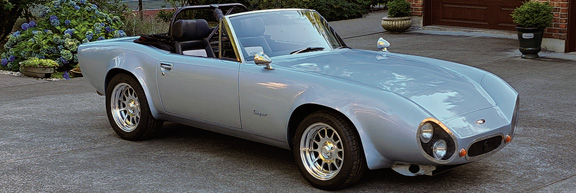|
|
Continued from Previous
Author Mike Lawrence pointed out in 1991 in his book
"A to Z of Sports Cars" that the Daytona was a brute to drive (I have read that on the web from former Daytona owners – lots of weight and no power steering) and the Dino GT could be faster from point A to point B. Horsepower isn't everything when it comes to sports cars; it's horsepower, torque, braking and handling that count. The Ferrari has a higher top speed but my J-C is small & nimble and is faster to 60 mph & faster to ¼ mile. Daytona
[see
full Daytona road test here] owners will hate me but it was just not the car for me. I have always thought of the Daytona as Ferrari's version of the Corvette, much better but still big and heavy.
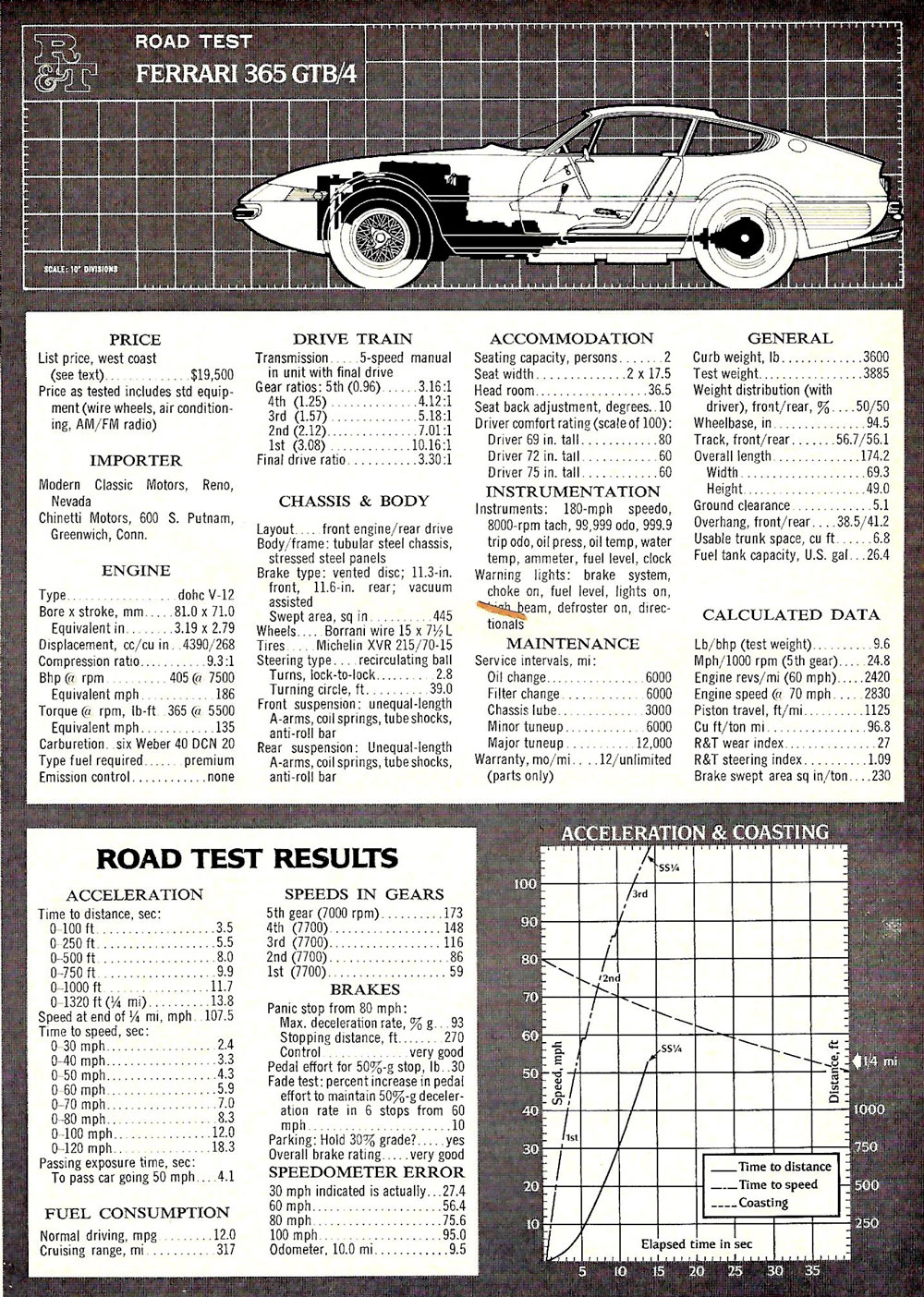
1973 SCCA National Champion Jensen-Healey vs FIA Ferrari Daytona
In 1974 Road & Track ran two fascinating road test articles – in September a track test of an SCCA championship winning race prepared Jensen-Healey [with a stock J-H for comparison] and in November a track test of an FIA Le Mans Ferrari Daytona [also with a stock Ferrari Daytona for comparison], both at the old Riverside Raceway, [Southern California] 2.56 mile short track.
What was fascinating, and what convinced me that a 1973 Jensen-Healey was the potential convertible high performance sports car I had been looking for, was that the SCCA J-H, with Lee Mueller [an SCCA championship driver] at the wheel, was almost as fast around the Riverside race track as the FIA Ferrari Daytona that had raced and finished third at Le Mans, with Sam Posey driving, both at Le Mans and at the Riverside race track test. Sam Posey was a well known and moderately successful professional sports car, Can-Am, Formula A/5000 and Formula One driver in the 1970's.
The FIA Ferrari Daytona was only 1.2 seconds a lap faster around Riverside than the SCCA Jensen-Healey. The Ferrari lap time was 1'35.2” and the J-H lap time was 1.36.4” and the stock Ferrari Daytona was 1'44.0”.
Keep in mind that the FIA race prepped Ferrari had a V-12 engine with over 400 bhp, four wheel disc brakes, independent rear suspension, 5-speed transmission and an aerodynamic coupe body, while the SCCA D Production class J-H had a 2.0 liter Lotus 907 inline 195 bhp four cylinder engine with an inadequate 4 speed transmission, rear drum brakes, a live rear axle and a very un-aerodynamic convertible body.
A very impressive performance, and the way that the J-H almost out performed the Ferrari was for exactly the same factors I was looking for in my search for a perfect sports car; small size, lightweight and great handling. The J-H must have been much faster through all the corners than the Ferrari and almost as fast on the straights …. it was a 1000 pds lighter than the Ferrari. Perfect.
Now, the important thing to remember that this track test was of the SCCA Jensen-Healey; my Jensen-Cooper has a 2.5 liter version of the Lotus 907 engine with much more bhp [250 bhp vs 195 bhp] much more torque and at a lower and longer rpm curve [210 ft-pds vs 155 ft-pds], a perfectly spaced close ratio road racing 5-speed transmission, a limited slip differential, 4 pot front disc brakes, larger [and better] wheels and tires and a more streamlined front end for better aerodynamics, with almost all of the suspension modifications of the racing J-H. Better acceleration and a higher top speed with better braking.
It seems to me that my Jensen-Cooper would be faster [much faster?] than the SCCA J-H. If it was just 1.3 seconds a lap faster, which seems obviously possible, then that would make my car faster than the FIA Ferrari Daytona, at least around a short course with a lot of curves and no 3 mile long straight like at Le Mans.
F.Y.I:
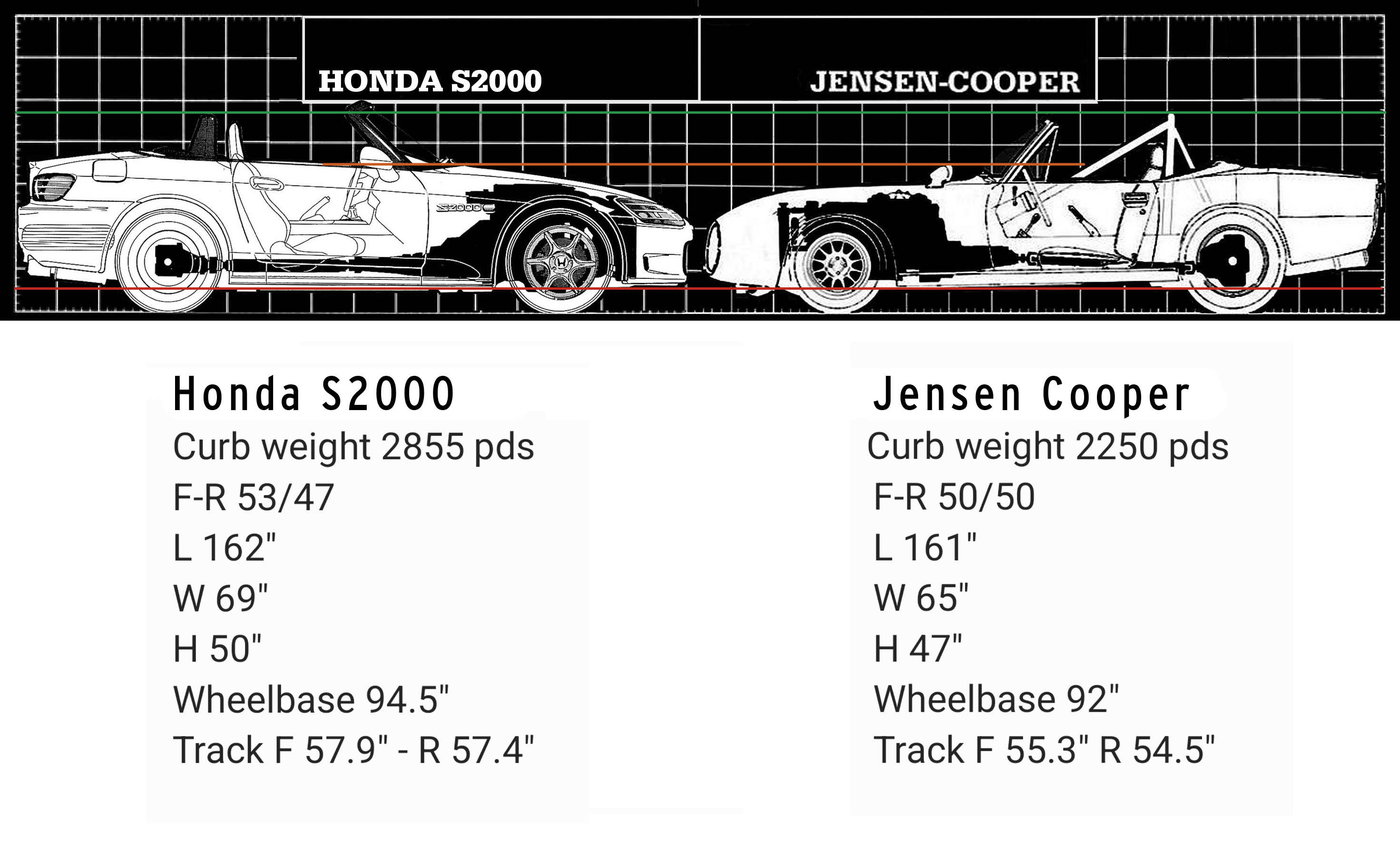
Even Carroll Shelby thought the Cobras were rude and crude but he built them to go international racing against Enzo Ferrari, which led to the Cobra Daytona Coupe and an American World Championship in 1965.
The convertibles offered very affordable high performance at the time, but they were a complete aerodynamic brick and everyone knew it. That's why Shelby wanted an aerodynamic coupe, to go road racing against the Ferrari GTO's. Very popular for replica cars, but not for me, as I thought I could do better, and I think I did. At least for my own car. I think my J-C is much smoother looking, more aerodynamic, although maybe not as fast as a new kit car Cobra.
Peter Egan and Tom Cotter
drove 3161 miles Cross County Road Trip in 2002 in a dead Stock 1965 Shelby Cobra.
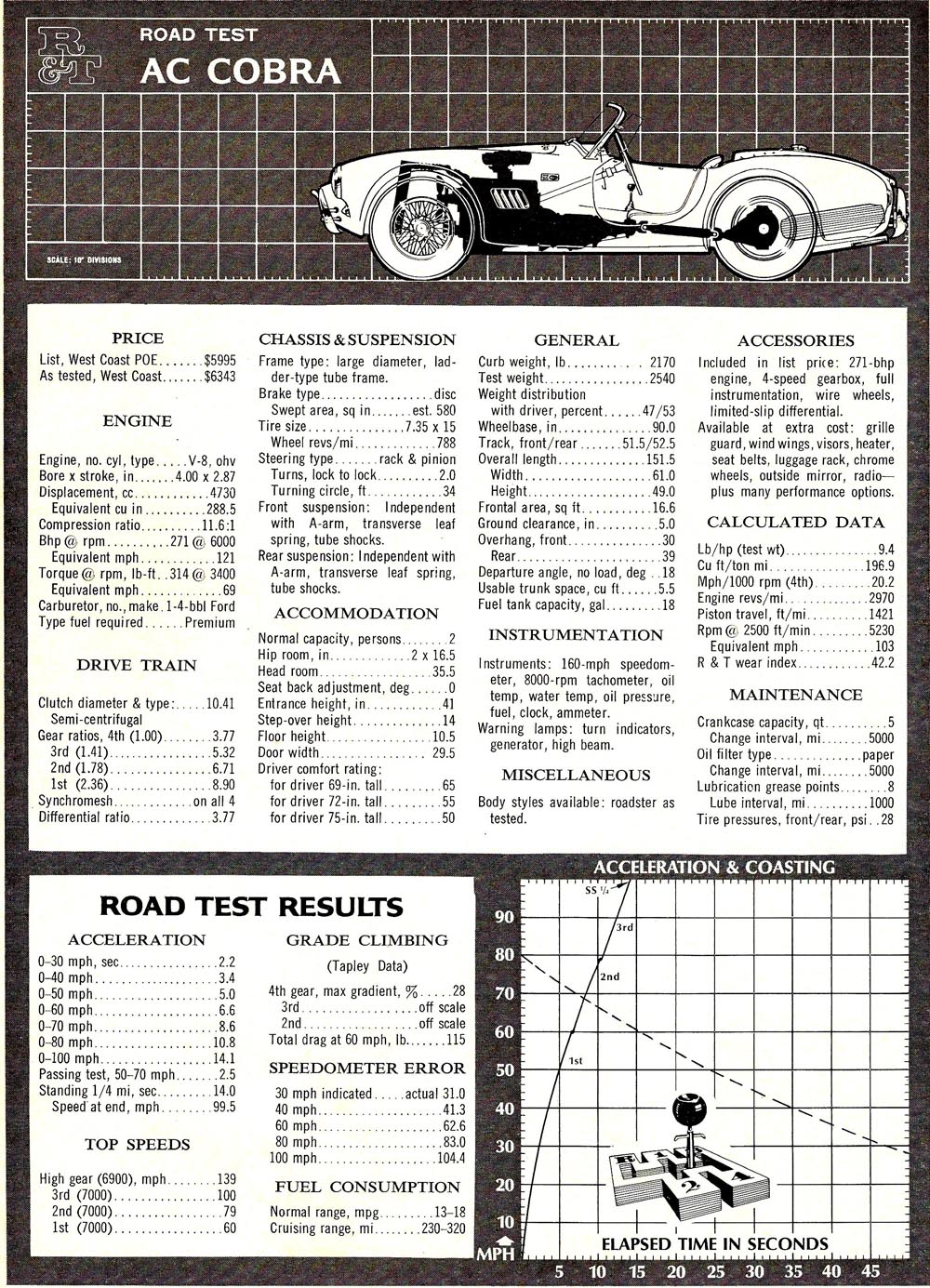
And there you have it. As far as I am concerned I have built a great little vintage sports car. It may not be the perfect car for anyone but me, but it sure stacks up great against all the other cars I was interested in. Even some much more modern cars from BMW, Porsche and Honda.
It is a convertible (absolutely no compromise there) with a good looking ragtop and roll bar
(for track days), very fast, great handling, simple, lightweight, affordable, comfortable, easy to drive, and beautiful in a classical sense of 1960's sports cars - what more could I ask for?
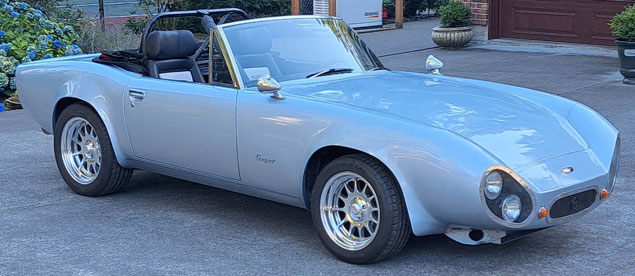
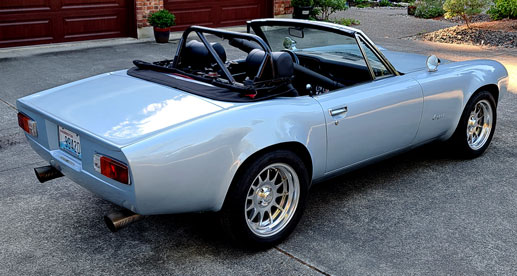
There is another point I would like
to make. Everything on the car is
basically vintage 1972 except the
tires and the electronic fuel injection - but mechanical fuel injection was available in 1972 as were the 4 piston disc brakes, wheels etc.
The
engine is from 1972 with some structural upgrades to the block which anyone but Colin Chapman would done from the beginning and even he eventually redesigned the block to make it stronger [the Lotus 912 block]. The cylinder head is the same 4-valve head from 1972. I could have bought a 300 hp engine from
Lotusbits but I preferred a high torque at low rpm street engine to a high rpm/hp - low torque racing engine. Even Honda figured out the same thing on the S2000 and went with a 2.2 crankshaft, just like Lotus did with the 907 20 years earlier.
Lotusbits just took it one logical step further and stroked the 907 to 2.5 liters.
On top of that my car has one thing that none of modern sports cars have. I was born in 1954 and became fascinated with sports cars in the early 60's and racing in the days of the Shelby Cobra, Ford GT 40, Jaguar XK-E, Ferrari GTO, Aston Martin Zagato, Maserati Ghibli, Lamborghini Miura, etc. and sports car racing at tracks like Le Mans, Sebring, Daytona, Targa Florio, Monza, Nurburgring, Silverstone and Brands Hatch, Spa, etc. It all seemed so exciting and fascinating
(and incredibly dangerous) but I was too young and way too poor to participate
(and, let's face it, no talent at all).
My Jensen-Cooper looks, drives and sounds like a high performance sports car from the 60's, with all the good points and bad ones.

I agree that modern sports cars are better in every way, but I still much prefer the older cars. My car does not have ABS, traction control, sound system, power steering, power brakes
(but a vacuum booster from the 60's),
power windows or electric
transmission . It is as close to a
1960's racing sports car as I could
make and still use it on the street
everyday. So this my way to
experience in a small way some of
things I missed in the racing world
of the 60's and 70's . When I am
driving my car I can be Jackie
Stewart, Stirling Moss and Phil Hill
rolled into one (Ha! Why not? All of us sports car fans have a little Walter Mitty in us, right?).
And that is something that no modern car can recreate and why I will never sell my car.
While I am at it, if anyone is interested, I admit that I have spent about $160,000
(maybe 50% of that on mistakes) on this project, but that is over a time span of 40 years, so only about $4,000 a year, including gas, insurance, but with a lot of down time for my stroke and not having any money. I also have a spare fully rebuilt 2.2 liter engine, spare rebuilt Getrag 5 speed gearbox, plus lots of other parts
I may need.
Not too much time and money to spend for a car that I would rather have more than any other sports car.
I don't have any regrets, at all. I don't mind the money. Well, I wish it hadn't taken so damn long.
|
I would like to thank all the wonderful people at Road & Track for publishing such a terrific magazine for so many years. I have well over 600 issues [from 1957 to the present] that I have used in this project. Most of the data that I have used here has come from those 40 and 50 year old articles. I couldn't have done it without your help. Thanks again.
The Ultimate Jensen Healey site is
maintained by Prestek Design Services, Bothell, WA
|
|

